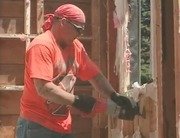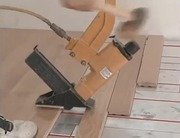Alright so we're in the room across the way from the nursery now, which will be guest bedroom , and Ed Waller's here from CertaPro.
And I want to talk about the kind of paints that were using and some tips on how to paint, because these are old plaster walls.
Now, what kind of paint?
It's latex paint, right?
Yep.
This is latex paint.
It's a noVOC paint.
Now V OCs are volatile organic compounds.
Which is what the chemists want us to call them, but basically it's what makes the paint stink.
Right?
Yeah.
Paint thinner and the old oil based paints.
And in latex paints ?
A variety of different modern chemicals--ethylene glycol, proplyene glycol.
But these paints, they've done away with all that stuff?
That's right.
These paints have a special resin, doesn't need any solvents to form a good solid film.
Right.
Very advanced, very high-tech.
So we're in here breathing it, and it's not bothering us and I can attest to the fact that Doesn't stink in here.
Yes, it's almost pleasant.
Now again, with VOC, you can't get too confused, because the fact is that once it's dried, it's over with.
There's really no harmful effect.
Pretty much.
Than the older paints.
Yeah, yeah.
Once it's dry to the touch, the vast majority of the solvent's in the air.
And as fast as you can ventilate the property or the home you're ready to go.
It's all dissipated.
Yeah.
What about the actual ability of this sort of paint to grip to to, to what's, underneath it?
You're actually getting a superior resin in these latexes than you would you, say with basic latex paint.
Usually when you get, you know, no
fat food or fat-free stuff or all this healthy things they don't taste as good.
But in this case, I think you actually get a superior product and it's not that much more money.
You can buy these products for a few gallons, a few dollars a gallon more.
Right.
Rarely do we do just one coat, because there's always little voids.
When the paint dries, it shrinks, there's going to be literally settling on the paint film, so...
No it's very good point.
Because during that first coat application, you're scanning your eyes over every square foot of...
That's right.
wall surface, so that you can see where you need to come back and...
Yep.
...do a repair.
You're gonna notice the bad spots.
For sure.
You can't see them in a normal unpainted wall.
Now, is there a reason why he's, you know obviously you cut in before you roll.
Yep.
And he's cut in beautifully up here at the ceiling line with a very steady hand.
And he's cut in where we have the roof eave line.
Yep.
But down here at the baseboard below the windows, I'm just noticing that he hasn't cut in.
He's let the yellow, kind of, go over the moulding.
Yes.
In an old house like this, where the trim's got a lot of edges, and it's not very even.
The idea here is to overlap the wall paint onto the trim.
That gets the void and the area between the wall and the trim all covered with one solid color.
And that way when you come back to--
With the trim paint, a good craftsman will draw a nice straight line.
What about your radiators.
He's, he's, he's painting right over the radiator.
Isn't that a problem?
That's a good point.
No, it's, it's not a problem.
A lot of people don't realize that these old metal radiators in homes are really just painted with ordinary latex wall paint.
If there's rust, obviously, we need to spot-prime with a rust primer, but otherwise no, a normal paint stick to these.
It doesn't affect the heat or their properties.
Yeah.
And you can decorate them to match your room.
Right.
Just like this one.
Ed, how do you find a good painte?
Look at what he's done, talk to people he's worked for and in our case we'll try him out in the field with an experienced, job site supervisor.
You know, that's one of the things.
A lot of people go into the painting business who haven't been trained properly.
That's right.
And you sometimes end up with very unhappy clients.
Yes.
And we train our key staff and when we bring on new people to work as helpers and painters and apprentices they're under the watchful eye of someone that we have trained.
You'll notice when he's rolling these wall.
walls, a couple of things.
He's using an extension pole.
One thing that a lot of people miss when they're painting, especially doing it themselves, they don't think to invest 20 bucks in a extension pole, and I will tell you it's really hard to paint with just a roller sleeve with just your hand.
You really gotta put an extension pole on there, and a decent one that fits your hand.
You'll also notice he's rolling from floor to ceiling.
A lot of people will paint a little square.
He is very purposely, on each load of that roller , painting roughly two roller widths.
That's how you know how much paint to use, and that's about the spread rate of a gallon of paint.
You should go floor to ceiling two roller widths , and that's how you paint.
Great.
That's exactly what you are showing us here.
Fastest most efficient way to put the right paint on in the right quantity.
Now, are we using a different type of paint for the trim?
Yes.
On the trim Justin's painting here with a semigloss paint.
the walls we did a eggshell.
That's always a good idea.
But I meant is it still low VOC?
Yes this is actually still an O VOC paint.
It's Sherwin Williams Harmony line.
They make a full range flat, eggshell, semi-gloss, even the primer he's painting over top of
The primer as well!
was an O VOC primer, that's right.
Oh, that's great!
Yeah and it's actually if you look, if you look at this trim where he is painting.
That was dark red.
The importance of a steady hand is obviously at the top of the list when you're, when you're doing that.
Yes, this is where the craftsmanship comes in when your getting a paint job.
The quality of that line is what your eye is going to look at
What kind of a paint brush should we use?
In this case he's using, looks like a Purdy synthetic like a polyester bristle, those are pretty expensive brushes.
Are those are the ones exploded tips?
Yeah, I think they call them flared or flagged tips.
They flag them.
But it's not a china bristle.
No you wouldn't want to use that with Latex.
They expand and bloat.
And they don't spread the paint very well.
So those are best used with old fashioned varnishes and that sort of stuff?
Smelly oil-based paint, yes.
Lots of VOC's in those.
Yeah.
That brush there is probably twenty bucks.
I noticed they paint out of a pail.
Is that important?
Well you'll notice the way he paints.
He doesn't really scrape the brush on the side.
He just taps it a little to get rid of the loose paint.
On the walls of the pail?
Yes.
And having a pail with a large open mouth like that just makes it easy to get in and get the paint out.
So, baseboards are a little bit easier then a panel door right?
Any tips?
Well, a flat panel door, a flat door we might just roll, and get a nice, like, light stipple texture.
A lot of doors are all ready like that.
In this case we have an old wooden door.
It was previously finished with varnish or it wasn't even painted.
And we want to leave a nice brush texture, so, we're going to paint the entire door by brush.
We're using our big four inch brush.
And our standard procedure on almost anything we paint and we'll follow it with this door is we do the hard stuff first.
We work inside out, top to bottom, left to right.
Inside out means from the deepest part like the canal.
Deepest out part out to the farthest out part so we're not sort of painting the frame while we're still going around it to get to the door.
And tape those nice old brass hinges and take off the door knobs, the obscutions, the keyhole covers, all the antique elements.
Absolutely.
So that you don't get any paint on it.
Yeah, and then when the door, before the paint dries we'll pull the tape off.
So we can get a bridge.
Alright.
Ed, thanks for the tips.
OK, Bob.
Thank you.







